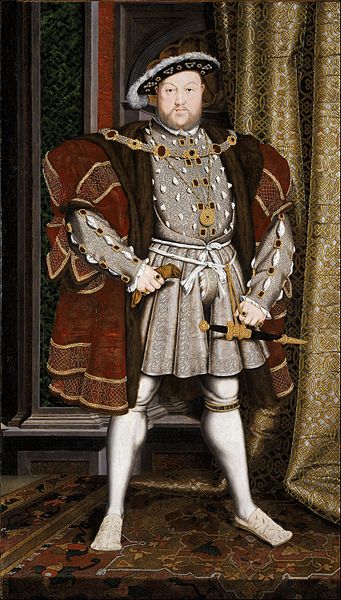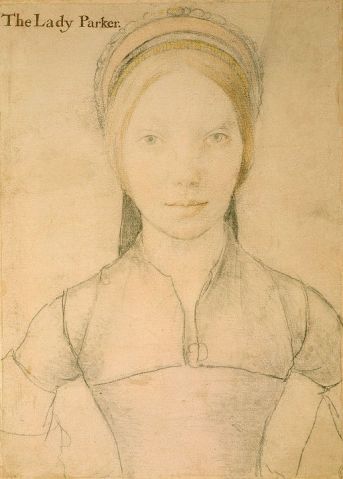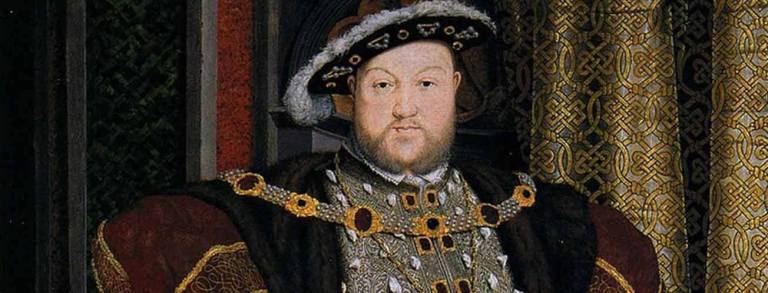Christmas with the Wives of Henry VIII by Alison Weir

Christmas in Tudor England is always described as a season of great feasting and revelry, but, then as now, it was a time when sadness was more poignant. That was sometimes the reality of the festive season for the hapless wives of Henry VIII.
Henry’s first wife, Katherine of Aragon, came to England in 1501 to marry his older brother Arthur. She had been married little more than a month when she spent her first Christmas in England, and it was not observed in the traditional way, for the young couple had left court on 21 December and were on their way to Ludlow Castle at a time when they would normally have been enjoying the festivities. We know that Katherine was homesick for Spain, and being so far from her family in a cold country in the depths of winter must have been hard, but that was not the only thing to make her sad. It was during that Christmas that it first became apparent that Arthur’s health was in decline. He died in April.
Seven years later, his brother Henry VIII succeeded to the throne and married Katherine. Her first Christmas as Queen, in 1509, was a joyful one, and saw the earliest pageant staged in Henry VIII’s reign, when twelve men dressed as Robin Hood and his Merry Men burst unannounced into Katherine’s chamber, ‘whereof the Queen, the ladies and all other there were abashed’. But musicians struck up a tune and they entered into the spirit of the occasion, dancing with the ‘outlaws’. Predictably, when the masks were removed, Robin Hood turned out to be the young King in disguise. Gifts were exchanged on New Year’s Day, and in 1510 Katherine’s first Yuletide present from Henry was a beautifully illuminated missal.
Christmas was an occasion when carols were danced and sung in the great hall while the Yule log crackled on the hearth, ‘to the great rejoicing of the Queen and the nobles’. Twelfth Night on 5 January brought the twelve days of celebrations to a close, but the Yuletide season officially ended with the solemn celebration of Candlemas, the feast of the Purification of the Virgin Mary, on 2 February, when the King and Queen went in procession to Mass.
Katherine did not participate in the festivities in 1510. ‘At this time the Queen was great with child, and shortly after this pastime she took [to] her chamber’ for her confinement, remaining there while the King kept Christmas in open court. On New Year’s Day 1511, Katherine was happily ‘delivered of a Prince, to the great gladness of the realm’. The little prince was christened Henry on 5 January, at Richmond ‘with very great pomp and rejoicing’. After the disguisings that marked the feast of the Epiphany on 6 January, the King went to give thanks at the shrine of our Lady of Walsingham in Norfolk. Sadly his son died aged six weeks.
In 1514, Katherine fell from favour after Henry was duped by her father, but by Christmas things had improved. When he took part in a disguising, she showed herself especially pleased, and when he brought masked lords and ladies into her chamber for dancing, she ‘heartily thanked the King’s Grace for her goodly pastime and kissed him’.
In 1517, Henry deemed it prudent to keep ‘no solemn Christmas because of an outbreak of the dreaded sweating sickness, and the court was closed. But at Eltham Palace, Henry and Katherine watched a masque entitled ‘Troilus and Cryseide’, which was based on the old tale made popular by Geoffrey Chaucer. After that masques were staged more frequently at court, and eventually replaced pageants as its chief form of dramatic entertainment.
For the Christmas of 1526, Henry had the ten-year-old Princess Mary brought to court, to Katherine’s great joy, and there were ‘great plenty of victuals, revels, masques, disguisings, banquets and jousts’. The King led his daughter out before the court, and the poet John Skelton captured the moment in his verses: ‘I saw a king and a princess dancing before my face, more like a god and a goddess… This King to see with his fair flower, the mother standing by, it doth me good…’
Alas for Katherine, by the time the next Christmas arrived, Henry had resolved to divorce her and marry the alluring and ambitious Anne Boleyn. Despite the Queen’s protests, Cardinal Wolsey was doing his utmost to procure an annulment, and in 1528 the Pope sent a legate, Cardinal Campeggio, to try the King’s case. That year, Wolsey and Campeggio were the guests of honour when, ‘to quicken his spirits, the King kept his Christmas at Greenwich with much solemnity’, laying on jousts, banquets, masques and disguisings for their entertainment. But Katherine ‘made no great joy, her mind was so troubled’; her only pleasure was in the company of her daughter Mary. The French ambassador noted that, while open house was kept as usual by the King and Queen, ‘Mademoiselle Boleyn is also there, having her establishment apart, as, I imagine, she does not like to meet the Queen’.
Matters had moved no further forward by the Christmas of 1529, which was spent at Greenwich, and kept by Henry and Katherine ‘in great triumph, with great plenty of viands and divers disguisings and interludes [short plays]’. But the concept of radical religious change was on Henry’s mind, and on Christmas Eve he told the Queen that, if the Pope pronounced sentence against him, he would not heed it, adding that ‘he prized and valued the Church of Canterbury as much as the people across the sea did the Roman’. Severing the Church of England from Rome was an idea entirely repugnant to Katherine, and she had difficulty in believing that this was what the King really intended. Besides, she had heard gossip. She put it to Henry that he was now sleeping with Anne. But he denied it.
Anne was out of sight at Hever Castle, but not out of mind, for at New Year Henry sent her a gift of money. On New Year’s Eve the Queen told Chapuys that Henry would eventually ‘come back to his senses, as he had always done before’. That prospect now seemed remote.
The Christmas of 1530 was even more dismal for Katherine. She had been ill, but was well enough to join Henry at Greenwich to keep ‘a solemn Christmas’, at which the Princess Mary was again present. It was not a happy occasion. On Christmas Eve Katherine accused Henry of setting a scandalous example by associating with Anne, to which he retorted ‘that there was nothing wrong in his relations with Anne, and that he kept her in his company only to learn her character, as he had made up his mind to marry her. And marry her he would, whatever the Pope might say.’
The royal couple sat enthroned together on Twelfth Night, when there were ‘divers interludes [short plays], rich masques and disports, and after that a great banquet’. But Henry was in a self-pitying mood. ‘The King much lamented his chance; he made no mirth or pastime, as he was wont to do, yet he dined with and resorted to the Queen as accustomed; he diminished nothing of her estate, and much loved and cherished their daughter. But in no wise he would not come to her bed.’ On New Year’s Day, the Spanish ambassador, Eustache Chapuys, was alarmed to hear that Henry’s marriage to Anne would be accomplished in the new session of Parliament.
It was not. Weary of Katherine’s stubborn insistence that she was his lawful wife, Henry banished her from court in 1531. That year he ‘kept his Christmas at Greenwich with great solemnity, but all men said that there was no mirth in that Christmas because the Queen and the ladies were absent’.
On New Year’s Day 1532, Anne Boleyn returned to court after visiting her family at Hever Castle, and was ‘lodged where the Queen used to be, and accompanied by almost as many ladies as if she were queen’. She was so visibly in the King’s favour that in London the common people ‘said that the absence of the Queen was only for her sake’.
That New Year, Katherine sent Henry a gold cup, ‘with honourable and humble words’, but he sent it back with a curt message commanding her not to send him such gifts in future, for he was not her husband, as she should know. ‘He has not been so discourteous to the Lady,’ observed Chapuys. Anne had given him ‘darts of Biscayan fashion, richly ornamented’, and in return he had given her ‘a room hung with cloth of gold and silver and crimson satin with rich embroideries’. Henry even remembered her sister, his former mistress, Mary Boleyn, who received a shirt with a collar of black-work embroidery.
The King kept the Christmas of 1532 in London, while Katherine spent it isolated at Enfield. Anne was now his mistress and, although neither of them knew it, she was pregnant with the future Elizabeth I. Henry would defy the Pope and marry her in January, and she would be crowned queen in June. Soon the break with Rome would be finalised.
At Christmas 1533, Katherine was in exile in the cold and damp tower at Buckden, refusing to obey Henry’s order to move to Somersham, an even unhealthier lodging. To enforce her obedience, the King sent the Duke of Suffolk to Buckden with a detachment of guards. But Katherine locked herself into her chamber, and there she spent Christmas, refusing to come out. Gradually local men began to gather silently outside the walls, armed with scythes, pitchforks and other implements. They did nothing, but watched and waited for any sign of ill-treatment of the woman they still held to be their queen. Suffolk grew increasingly uneasy, but it was not until 31 December that he received instructions from the King bidding him leave Katherine to her obstinacy and return to court.
That Christmas, Anne’s new maid-of-honour, Jane Seymour, was one of several ladies who received a gift from Henry VIII.
The Christmas of 1534 was not a happy one for Anne Boleyn, who had lost her second child late in pregnancy. Her beloved dog, Little Purkoy, had just died after falling out of a window; the King had broken the news to her, as no one else dared. During the festivities Anne quarrelled with her uncle, the Duke of Norfolk, who told Henry that she had ‘used terms to him which would not be used to a dog’, at which Norfolk had called her ‘a great whore’. Once Henry would have taken exception to such a gross insult to Anne, but not anymore. He himself was finding her especially ‘vexatious and importunate’. In May 1536 Anne went to the scaffold, condemned to death for treason, and ten days later the King married Jane Seymour. He and his new queen were at Windsor in early December, planning their first Christmas together at Greenwich. The winter of 1536–7 was bitterly cold, and the roads were iced up, but this did not deter the King from summoning Mary to court for a public reconciliation in which Jane had been instrumental.
Just before Christmas, the Thames froze in London. On 22 December, Henry, Jane and Mary, warmly wrapped in furs, rode on horseback from Westminster to the City, which was gaily decorated in their honour with tapestries and cloth of gold; priests in copes with crosiers stood at every street corner waiting to bless the royal party and, in spite of the bitter cold, the people turned out in large numbers to watch the procession, cheering loudly. After a service in St Paul’s to mark the beginning of the Christmas celebrations, Henry and Jane then spurred their horses across the frozen river and galloped to the Surrey shore. Then they rode to Greenwich Palace, where they would stay for Christmas, with Jane presiding for the first time over the glittering Yuletide court.
Yet the season was marred for her by news of the death of her father, Sir John Seymour, on 21 December at Wulfhall, his house in Wiltshire. He had never lived in the public eye, so there was no observance of court mourning for him and the festivities went on. On New Year’s Day, Henry and Jane gave Mary costly presents, as did Thomas Cromwell.
In October 1537, after presenting Henry with his longed-for heir, the future Edward VI, Jane died in childbed, plunging the King into genuine grief. That year he spent a very quiet Christmas at Greenwich.
At Christmas 1540, Henry’s fourth bride, Anne of Cleves, was at Calais, awaiting a favourable wind to take her to England, and being entertained with banquets and jousts. The Lord Admiral, William Fitzwilliam, Earl of Southampton, having discovered that she did not play cards, one of the King’s favourite pastimes, was teaching her.
On 26 December, a fair breeze was blowing, and the Admiral judged it prudent to set sail for England. The voyage took seventeen hours. Anne spent her first night in England at Dover Castle. The weather turned bitterly cold, with freezing storms, but she insisted she press on towards London, so ‘desirous was Her Grace of reaching the King’s presence’. On Monday, 29 December, with hail and sleet blowing continually in her face, she got as far as Canterbury, and on New Year’s Eve arrived at the Bishop’s Palace in Rochester.
So eager was Henry to meet her that, on that same day, he set out to Rochester ‘to nourish love’. When he arrived, he welcomed Anne to England with great courtesy, while she, ‘with most gracious and loving countenance and behaviour’, sank to her knees to receive him. He raised her up gently, kissed her on the mouth, and stayed for supper. But when he had left her, he was scowling ferociously and complaining that he had never been ‘so much dismayed in his life as to see a lady so far unlike what had been represented’. It was a disastrous beginning to a short-lived marriage. In July 1540, it was annulled, and the King immediately took Katherine Howard as his fifth wife.
Henry and Katherine went to Hampton Court for their first and only Christmas together. The King’s New Year’s gifts to his wife were lavish, and included diamonds, pearls and a muffler of black velvet edged with jewelled sable fur.
The New Year revels of 1541 brought together an unusual family gathering. Mary had come up from Hunsdon, and Anne of Cleves was also at court, and got on famously with her successor, the young Queen. Anne had sent the King and Queen two great horses with violet velvet trappings before arriving at Hampton Court on 3 January. That evening, the King retired early, but Anne stayed up dancing with Katherine, and the next day dined with her and Henry. When Henry gave his wife a ring and two small dogs, she generously passed them over to the Lady Anne.
Katherine would spend the Christmas of 1541 under house arrest at Syon Abbey, awaiting her fate, having been arrested in November and accused of treason. On 10 December the men apprehended with her had been put to death. At court the festive season passed gloomily that year, with the King making no effort to join in the half-hearted revels staged by his courtiers. He was ‘sad, and disinclined to feasting and ladies’. He was also putting on weight, and looked very old and grey.
Katherine Howard was beheaded in February 1542. In July 1543, Henry VIII married his sixth wife, Katherine Parr. Her first Christmas season as queen was overshadowed by war with Scotland, yet the festivities at Hampton Court went on much as usual.
At Christmas 1544, Chapuys took the opportunity to thank the Queen, on behalf of the Emperor, for all that she had done for the Lady Mary. He could not help but admire her. She was, in his opinion, a very pleasant and well-meaning person, whose goodwill could be used to advantage when it came to preserving the alliance between his master and Henry VIII. Yet Chapuys feared he would not be there to use this advantage: he was growing old and nearing retirement, and was so infirm that he was now confined to a kind of wheelchair on occasions. He would soon be recalled.
At New Year 1545, Henry’s eleven-year-old daughter Elizabeth sent her stepmother her own translation of Margaret of Navarre’s The Mirror of the Sinful Soul, a devout meditation on the love of a Christian soul towards God and Christ. It was dedicated: ‘To the most noble and virtuous Queen Katherine, Elizabeth, her humble daughter, wisheth perpetual felicity and everlasting joy.’
Christmas Eve, 1545 found the King ‘so unwell that, considering his age and corpulence, fears are entertained that he will be unable to survive further attacks’ of illness. On Christmas Eve, 1546, he prorogued Parliament for the last time, and spoke ‘so kindly, so rather fatherly, that many of his hearers were overcome and shed tears’. It was obvious to everyone present that this would be the King’s last public speech.
That Christmas the court was closed. Henry was failing. The Queen and the Lady Mary were the only members of his family in attendance. Two days after Christmas, Henry’s physicians despaired of doing anything to help their royal patient, who was ‘in great danger’ and ‘very ill’. Reports that he had died already were circulating in the capital.
On 30 December, Henry dictated his will. Then he rallied a little, and on 3 January 1547 was well enough to leave Greenwich and travel with the Queen to London. He died on 28th January at Whitehall. Katherine herself had only one more Christmas to celebrate; by then she had remarried. She died in childbed in 1548. They were now distant memories, those courtly Christmases when ‘many a gallant lord and lovely lady made rich revel and mirth, and were free from care, and the feasting was with all the meat and mirth men could devise, and glorious to hear was the noisy glee by day and the dancing by night; and all was joyous in hall and chamber.’
Alison Weir is an author and historian. KATHERYN HOWARD: THE TAINTED QUEEN, the latest title in her Six Tudor Queens series, is available now.








